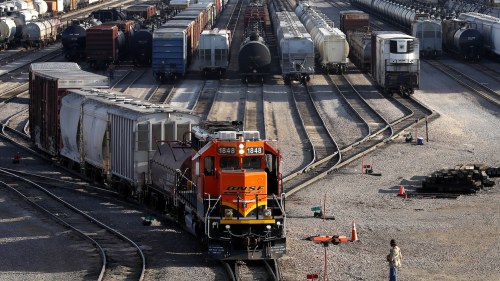Five features that define Chicago's role in global trade

Illinois and its largest city play crucial parts in the worldwide trade landscape. To understand what those parts entail, we spoke to World Business Chicago.
When the pandemic snarled foreign imports of everything from semiconductors to strawberries, shoppers and businesses in Chicago and beyond learned the hard way how complex and interdependent global supply chains are. Making sense of international trade issues like this can feel like doing a 5,000-piece puzzle in the dark — without the box.
Solving that puzzle is part of Karla Orozco’s job as head of foreign direct investment at World Business Chicago, where she works to attract foreign companies to the city.
“I understand trade and investment as a relationship,” said Orozco. “Trade, especially for foreign companies, is kind of the ‘dating’ [phase] of a relationship” when companies are getting to know the city, the state, and their clients before committing to any long-term investments.
We asked Orozco to break down what roles Illinois and Chicago play in the tangle of relationships that make up global trade. Here are the five essential basics she thinks you should know.
1. Our neighbors are our top trade partners — mostly
Illinois’ largest markets for exports by far are Canada and Mexico, with 2023 exports valued at roughly $20 billion and $13 billion respectively. That’s several times larger than the third- and fourth-largest export markets, Germany and China, which each bought about $4 billion of Illinois goods. In total, the state exported about $80 billion of goods last year.
Trade in the Chicago area looks a little bit different than the rest of the state. Japan was Chicago’s largest trade partner in 2023, with nearly $8 billion imported through O’Hare, followed by China and Germany, which imported roughly $5.5 billion and $5 billion respectively. Canada is fourth on the list with $4 billion in imports at O’Hare, and Mexico doesn’t crack the top five.
Still, that might be mostly a function of the way we measure trade, according to Orozco. Trade statistics are often measured from the first point of entry, she explained, which for many goods in Chicago is one of our international airports. Compared to the state at large, with its full breadth of freight transported by road or rail, this makes Chicago’s trade data skew toward geographically distant partners and away from Canada and Mexico, our less air-reliant neighbors.
2. Chicago is a central trade logistics hub for all of North America
Indiana calls itself “the Crossroads of America,” but Chicago might have the stronger claim. Six of the country’s seven largest railroads cross through the city, notes Orozco, as do 10 interstate highways.
“We are connecting the region to a quarter of the nation’s population within 500 miles,” said Orozco. “That’s very important for companies to understand, because time is money.”
The combination of that central location and the city’s strong transportation infrastructure makes Chicago an appealing distribution hub for foreign companies marketing products, not just in Illinois but across the region and beyond.
“It’s the gateway to the Midwest,” explained Orozco.
3. O’Hare is the third-largest trading port in the country
It may seem counterintuitive that one of America’s largest trading ports would be in the middle of the country, hundreds of miles away from an international border or a body of water with salt in it.
Still, in the first six months of this year, O’Hare International Airport was the country’s third-largest port by trade value, accounting for 5.3% of the nation’s trade. Only the Port of Los Angeles and the Port of Laredo, on the border with Mexico, ranked higher, with each handling about 6%. In 2023, O’Hare handled about $271 billion total in trade — larger than Greece’s annual GDP.
O’Hare’s is central to the nation’s trade “because of the transportation, distribution, and logistics ecosystem that we have,” said Orozco.
In addition, Orozco noted that foreign imports shipped by plane tend to be more valuable and to require costly refrigerated supply chains. The data bears that out: Smartphones, medicine, and vaccines were among the largest categories of imports at O’Hare, accounting for 13%, 9%, and 8% of the airport’s import value respectively. On the export side, life sciences were key, with products like medicines, vaccines, medical instruments, and pharmacological reagents comprised over a quarter of O’Hare’s export value.
O’Hare’s statistics are also boosted by a puzzling billion-dollar trade in crude oil. Orozco clarified that oil isn’t, in fact, being flown in by plane. Rather, the Census Bureau counts Canadian oil shipped by pipeline as part of O’Hare’s trade total.
4. Manufacturing and agriculture aren’t the biggest exporters, but they are still sources of strength
Illinois’ single largest export category is chemicals — a $15.6 billion trade bolstered by the Chicago area’s life sciences sector — but the state’s traditional economic engines still power many of its exports.
Among all of Illinois’ exported goods, seven of the top 10 categories are rooted in manufacturing, including machinery, computer products, transportation equipment, and metal manufacturing. Moreover, exports in these sectors are growing: They’ve increased by 34% on average since 2019, and primary metal manufacturing exports shot up 134% in that span.
Agriculture, especially corn and soybean production, is another Illinois mainstay: About $4.4 billion of agricultural products were exported in 2023, the sixth-largest export category overall. Agricultural exports have also doubled since 2019, buoyed in part by billion-dollar soy and corn deals with Taiwan, which relies on imports for much of its food supply.
5. Geopolitics is changing how Illinois trades, especially with China
China remains one of Illinois’ largest trade partners, but the trade balance is shifting. Illinois exports to China are up by more than 50% since 2019, but Chinese exports to Illinois in that time, while up modestly on the whole, took a noticeable downturn last year. That’s truer in some sectors than others. The state’s imports of Chinese computer electronics — the most valuable import category — dropped by 36% last year, and imports of Chinese chemicals shrank by over 50%. At the same time, Illinois exports of computer products and chemicals increased by 5.3% and 15.8% respectively.
As Illinois and China’s economic relationship has shifted, so has the politics of trade with the country. After the COVID-19 pandemic surfaced vulnerabilities in supply chains, especially for high-tech goods like semiconductors, policymakers started talking about “friendshoring,” “onshoring,” and “nearshoring” — in other words, moving supply chains out of China and into the U.S. or friendly countries.
Nearshoring has presented “new opportunities” for Chicago, said Orozco.
“We are open for business,” she said. “These Chinese companies are looking to manufacture, now, in Chicago…[they] understand the power of the U.S. market, and they will keep their products in the market.”
Gotion, a Chinese E.V. battery manufacturer, is one example of this, according to Orozco. The controversial firm chose Manteno, Illinois, as the location of its first North American factory, and production is expected to begin at the multi-billion-dollar plant later this year.
Why does trade matter?
“If you see rupturing in the supply chains, you feel it,” said Orozco.
“What you eat, what you wear — it’s probably from another country,” she explained. Whether it’s oranges from South Africa or sweaters from Sweden, trade impacts what Orozco describes as day-to-day, household economics.
“We live in a global space where everything is international now,” she added.
Illinois and Chicago are at the heart of it.
This story first appeared in the ChicagoGlobal newsletter, a joint project of Crain's Chicago Business and the Chicago Council on Global Affairs. Subscribe today.

